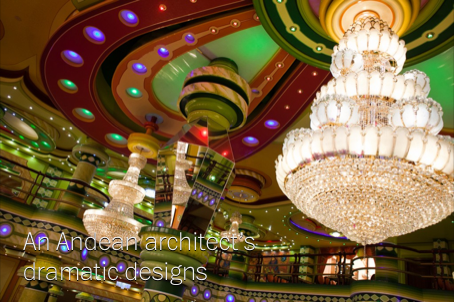In Bolivia, 'New Andean' architecture applies new money to old traditions
October 27, 2014 - Washington Post
By Nick Miroff
EL ALTO, Bolivia — Fanning out across the barren altiplano at 13,000 feet, this city is one of the fastest-growing in South America. It's going up so quickly it looks like it's still in sketchbook form, as if no one had time to add any color.
The streets are dusty and treeless. The houses and half-finished buildings are unpainted brick. A blinding sun blanches everything else.
"It's so monotonous," said architect Freddy Mamani, for whom this is clearly a problem and a personal irritant. "It's depressing."
Mamani wants to liven things up. You might want to reach for your sunglasses.
Walking into one of Mamani's buildings is like coming out of a rabbit hole into an electric Bolivian wonderland. It's a jolt to the rods and cones.
The interiors of his buildings feature two-story ballrooms that are a spellbinding tapestry of bright paint, LED lights and playful Andean motifs: chandeliers anchored to butterfly symbols, doorways that resemble owls and candy-colored pillars that could hold up a Willy Wonka factory.
One soaring wedding hall evokes the inside of a reptile, with arching roof beams that look like dragon ribs and huge orange curlicue moldings that could be alligator eyes.
"We use the colors of our textiles, colors that are alive," said Mamani, tracing his inspiration to the elaborate shawls and other traditional garments made by Aymara weavers like his mother. His buildings take those patterns, applied in plaster and paint.
Mamani, 42 and largely self-taught, is an architect with a rare kind of privilege. It's not often that a single artist or designer gets a chance to define the aesthetic of an entire city.
Gaudi did it in Barcelona. Niemeyer in Brasilia. L'Enfant, to a degree, in Washington.
Mamani is turning cold, gritty El Alto (population 1 million) into the world capital of "New Andean" architecture. This is in contrast to the old Andean architecture of the Incas and Mamani's Aymara forebears, who left their designs and symbols in the ancient city of Tiwanaku, between here and Lake Titicaca, built more than 1,000 years ago.
Mamani has big dreams for El Alto's plazas, bus stations and boulevards. But only recently have Bolivian authorities begun warming to his work.
Critics dismiss Mamani's work as kitsch, or something worse — "decorative." In the architecture departments where Mamani said his instructors were only interested in copying European forms, his bold colors and extravagant designs were not well received.
But in El Alto, Mamani is the Aymara version of Michelangelo. To his patrons — the city's newly affluent— his works are a status symbol.
Many are the traders who have changed El Alto from a slum into Bolivia's throbbing hub of street commerce. Next-door La Paz has filled the bowl-shaped canyon below it and has no more room to grow.
But El Alto, whose name translates roughly as "the Heights," starts at the canyon rim and sprawls outward, across the flat desert plateau of the altiplano, with plenty of space for new arrivals, new money and unconventional architecture.
Mamani moved to the city as a young man from a small rural town where farmers raised quinoa and llamas. His father was a bricklayer.
Mamani learned how to build from him, went to engineering school and began sketching out his designs by hand. He still works that way — no computer, no office, just a battered Toyota pickup and a cellphone that nags him every few minutes when one of his site managers needs something. Mamani's five younger siblings work for him, too.
He has completed about 60 structures, known colloquially in El Alto as "chalets." Mamani says their owners are typically well-to-do Aymaras who have been emboldened by the success of Bolivia's most famous Aymara, Evo Morales, the country's first indigenous president. Morales was reelected to a third term Oct. 12 by a wide margin.
"There have always been rich Aymara, but before Evo, they were timid. They didn't want to draw attention to themselves," Mamani said.
"Now they say, 'This is where the successful Aymara live.' They are proud of Evo, and they say, 'I have wealth, I can show it off. I don't have anything to hide.' "
Most of Mamani's buildings are five or six stories tall, with bright, bold facades of Andean symbols, tinted glass and geometric patterns in relief. Each unique structure is an all-in-one compound meant to satisfy all the commercial, familial and aesthetic needs of the modern, urban Aymara.
The ground floor offers street-level commercial space that the owner can use or rent. The second and third floors are exuberant ballroom spaces meant for weddings, parties and the "Sweet 15" birthday celebrations called quinceañeras — the big events Bolivians wouldn't think of having at home.
Covering the fourth and fifth floors are rooms for rent, or apartments for the owner's family. At the top of the building, offset from the street, is a penthouse structure — the actual "chalet" — typically with a gabled roof and huge windows meant to catch the sun's warmth and the views of snow-capped Andean peaks.
Most of his buildings have cost between $300,000 and $600,000, Mamani said. Some even more.
The architect has a dozen or so under construction, dividing his 200 workers into two brigades: one for basic construction, the other for detail work. His interiors are almost entirely done with plaster and heavy oil paints.
One structure he debuted this summer with a ballroom for 700 has already become a destination for curiosity-seekers. It has custom wall panels of Andean pastoral scenes, stages for two bands and a giant glowing chandelier at the center.
"People come from all over to see it," said Alejandro Chino, a successful haberdasher, pleased by his decision to commission Mamani. "It's the best place in all of Bolivia to get married."
